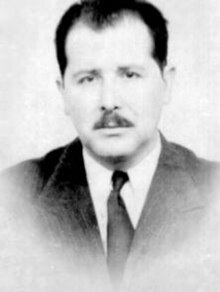Guillermo Haro
This article needs additional citations for verification. (March 2018) |
Guillermo Haro Barraza | |
|---|---|
 Dr. Guillermo Haro Barraza | |
| Born | 21 March 1913 Mexico City, Mexico |
| Died | 26 April 1988 (aged 75) |
| Alma mater | National Autonomous University of Mexico (UNAM) |
| Scientific career | |
| Fields | Astronomy |
Guillermo Haro Barraza (Spanish pronunciation: [ɡiˈʝeɾmo ˈaɾo βaˈrasa];[1] 21 March 1913 – 26 April 1988) was a Mexican astronomer. Through his own astronomical research and the formation of new institutions, Haro was influential in the development of modern observational astronomy in Mexico. Internationally, he is best known for his contribution to the discovery of Herbig–Haro objects.
Early life
Haro was born in Mexico City on 21 March 1913 to Ignacio de Haro and Leonor Barraza.[2] He studied philosophy and law at the National Autonomous University of Mexico (UNAM). While working as a reporter for Excélsior, Haro became interested in astronomy after a 1937 interview with Luis Enrique Erro.[2] As a result of his dedication and enthusiasm for astronomy, he was hired by Erro in 1943 as an assistant at the newly founded Observatorio Astrofísico de Tonantzintla. Erro arranged for Haro to further his astronomical training in the United States at the Harvard College Observatory, Case Observatory (1944), Yerkes Observatory and McDonald Observatory (1945 to 1947).[2]
Career
Upon his return to Mexico in 1945, Haro continued working at the Observatorio Astrofísico de Tonantzintla where he was responsible for the commissioning of the new 24-31-inch Schmidt camera and where he became involved in the study of extremely red and extremely blue stars. In 1947 he started working for the Observatorio de Tacubaya of the UNAM.[citation needed]

Haro's contributions to observational astronomy, were primarily made using the Tonantzintla Schmidt telescope.[citation needed] Among them were the detection of a large number of planetary nebulae in the direction of the galactic center and the discovery (also independently done by George Herbig) of the nonstellar condensations in high density clouds near regions of recent star formation (now called Herbig–Haro objects).[3] Haro and co-workers discovered flare stars in the Orion nebula region, and later on in stellar aggregates of different ages.[3] His intense activity detecting flare stars continued till the end of his life.[citation needed]
Other major research projects carried out by Haro included the list of 8746 blue stars in the direction of the north galactic pole published jointly with W. J. Luyten in 1961. Work made with the 48-inch Palomar Schmidt using the three-color image technique developed at Tonantzintla. At least 50 of these objects turned out to be quasars (which had not yet been discovered in 1961). Haro's list of 44 blue galaxies, compiled in 1956, was a precursor to the work of Benjamin Markarian and others in searching for such galaxies. Haro also discovered a number of T Tauri stars, one supernova, more than 10 novae, and one comet.[citation needed]
Major accomplishments
Haro was very influential in the development of astronomy in Mexico, not only by virtue of his own astronomical research but also by promoting the development of new institutions. In a more important aspect he defined modern astrophysical research in Mexico where he gave impulse to different initial lines of research and established general scientific policies.[citation needed] Guillermo Haro discovered a new type of large planetary nebula with Hawaiian colleague George Herbig - that were named Herbig-Haro objects.[3]
Haro became a member of the Colegio Nacional at age 40, the youngest person to do so.[4]
In 1959, Haro became the first person elected to the Royal Astronomical Society from Mexico.[2] Amongst his students were Silvia Torres-Peimbert and Manuel Peimbert.[2]
Haro founded the Mexican Academy of Sciences (first president 1960) and the National Institute of Astrophysics, Optics and Electronics (an observatory named after him is in the state of Sonora).[citation needed]
Recognition
Galaxy Haro 11 (H11) is a small galaxy situated in the southern constellation of Sculptor and is named after Haro who first included it in a study published in 1956.[5]
The Guillermo Haro International Program on Advanced Astrophysical Research at INAOE, which was created in August 1995, was named after him.[6]
On 21 March 2018, 105 years after his birth, Google featured Haro in a Google Doodle.[3]
Personal life

In 1968, Haro married journalist and writer Elena Poniatowska, with whom he had two children: Felipe and Paula.[7] He was previously divorced from his first wife, Gladys Learn Rojas.[citation needed]
Haro died on 27 April 1988 in Mexico City, and is interred at the Rotonda de las Personas Ilustres of the Panteón Civil de Dolores.[8]
See also
References
- ^ In isolation, Barraza is pronounced [baˈrasa].
- ^ a b c d e Bracher, Katherine; et al., eds. (2007). The biographical encyclopedia of astronomers ([Online-Ausg.] ed.). New York, NY: Springer. pp. 471–472. ISBN 978-0387304007.
- ^ a b c d Smith, K. N. (2013-03-21). Wednesday's Google Doodle Celebrates Astronomer Guillermo Haro. Forbes, 21 March 2018. Retrieved on 2018-03-21 from https://www.forbes.com/sites/kionasmith/2018/03/21/wednesdays-google-doodle-celebrates-astronomer-guillermo-haro/#1e8fc1f85d06.
- ^ "Google celebra con estrellas el legado de Guillermo Haro". El Universal (in Spanish). 21 March 2018. Retrieved 21 March 2018.
- ^ G. Haro (1956). "Preliminary note on blue galaxies with nuclear emission". Astronomical Journal. 1: 178. Bibcode:1956AJ.....61R.178H. doi:10.1086/107409.
- ^ Revista Mexicana de Astronomía Y Astrofísica: Serie de conferencias. Instituto de Astronomía, Universidad Nacional Autónoma de México. 1997. p. vii. Retrieved 21 March 2018.
- ^ Perez, Héctor Cruz (19 May 2015). "Elena Poniatowska de la A a la Z". Chilango (in Mexican Spanish). Retrieved 21 March 2018.
Contrajeron matrimonio en 1968 y tendrían dos hijos.... Con Juan José Arreola tuvo a Emmanuel en 1955 y con su esposo Guillermo Haro tuvo dos hijos: Felipe y Paula.
- ^ Digital, Milenio. "¿Quién fue el astrónomo mexicano Guillermo Haro y por qué está en el doodle?". Milenio (in Spanish). Retrieved 21 March 2018.
